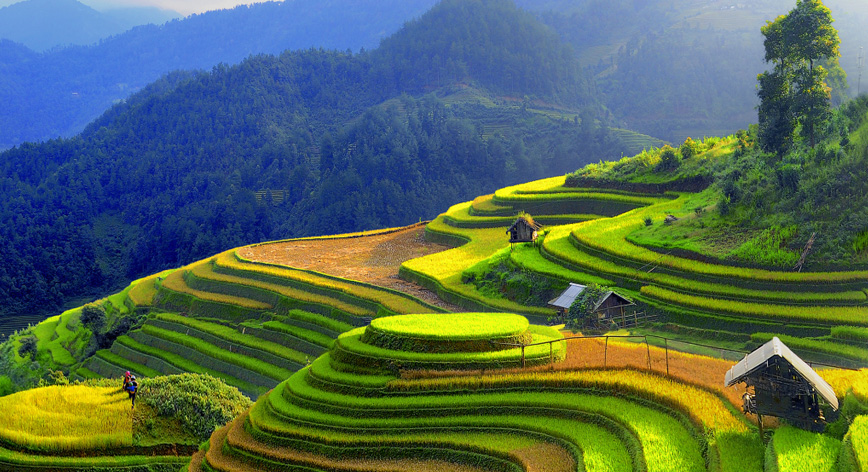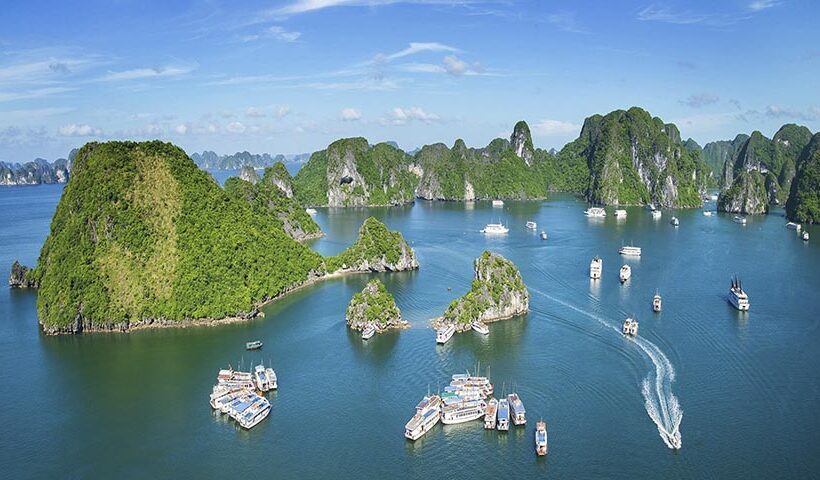Description
Sapa: The Ultimate Guide for Muslim Travelers
 Sapa Overview
Sapa Overview
Sapa, a charming town nestled in the northern mountains of Vietnam, is renowned for its breathtaking landscapes, terraced rice fields, and rich cultural diversity. The area is home to various ethnic minority groups, each with its unique traditions and customs. For Muslim travelers, Sapa offers a serene escape into nature, with opportunities to explore the vibrant culture and natural beauty of Vietnam’s highlands. Although Halal food and mosques are limited in Sapa, with proper planning, Muslim travelers can still have a fulfilling experience in this picturesque region.
Why Visit Sapa?
Sapa is a destination that captivates travelers with its stunning natural beauty and cultural richness. The town is surrounded by majestic mountains, deep valleys, and terraced fields that change color with the seasons. Sapa is also the gateway to exploring the traditional lifestyles of the Hmong, Dao, and Tay ethnic groups. Visitors can trek through scenic landscapes, visit local markets, and immerse themselves in the cultural heritage of the hill tribes. The cool climate, especially during the summer, makes Sapa a perfect retreat from the heat of the lowlands.
Best Time to Visit Sapa
The best time to visit Sapa is from March to May and from September to November. During these months, the weather is mild, with clear skies and pleasant temperatures. The period from September to November is particularly beautiful as the rice terraces are golden and ready for harvest. Winter (December to February) in Sapa can be cold, with temperatures dropping to freezing at night, but the snow-capped mountains offer a magical experience. The summer months (June to August) are warmer and wetter, but the lush green landscapes make it an ideal time for trekking and exploring the region.
How to Get to Sapa?
Sapa is accessible from Hanoi by various means of transportation:
- By Train: The overnight train from Hanoi to Lao Cai is a popular choice. From Lao Cai, it’s a short bus or taxi ride to Sapa. This option allows you to sleep during the journey and wake up refreshed in the mountains.
- By Bus: Several bus companies offer direct routes from Hanoi to Sapa. The journey takes about 6-7 hours, with options for day or night travel.
- By Private Car: For a more comfortable and flexible journey, you can hire a private car from Hanoi to Sapa. This option allows you to stop at various points of interest along the way.
Top Sapa Tourist Attractions
1. Fansipan Mountain
Known as the “Roof of Indochina,” Fansipan is the highest peak in Vietnam, standing at 3,143 meters. A cable car ride to the summit offers breathtaking views of the surrounding mountains and valleys. For the adventurous, a guided trek to the top is a rewarding challenge.
2. Cat Cat Village
Cat Cat is a traditional Hmong village located just a short walk from Sapa town. Visitors can explore the village to learn about Hmong culture, see traditional crafts, and enjoy stunning views of the terraced fields and waterfalls.
3. Muong Hoa Valley
Muong Hoa Valley is famous for its picturesque terraced fields and the Muong Hoa River. The valley is home to several ethnic minority villages, and trekking through this area offers a glimpse into the daily lives of the local people.
4. Lao Chai & Ta Van Hilltribe Villages
Lao Chai and Ta Van are two of the most picturesque villages in Sapa, located in the Muong Hoa Valley. These villages are home to the Black Hmong and Giay ethnic minorities, who maintain their traditional way of life. A visit to Lao Chai and Ta Van offers an authentic experience of rural life in Sapa, with opportunities to interact with local families, learn about their customs, and enjoy the stunning terraced landscapes. The trek to these villages is relatively easy, making it accessible for most travelers. Staying overnight in a homestay in Ta Van allows you to fully immerse yourself in the local culture.
5. Silver Waterfall & Love Waterfall
Located about 12 kilometers from Sapa, these waterfalls are popular attractions for visitors. Silver Waterfall cascades down from a height of 100 meters, while Love Waterfall is surrounded by lush greenery, offering a tranquil escape.
6. Sapa Stone Church
The Sapa Stone Church, built by the French in the early 20th century, is a prominent landmark in Sapa town. The church, with its distinctive Gothic architecture, is a reminder of the colonial history of the region.
Sapa Travel Tips for Muslim Travelers
- Halal Food: While Halal food options are limited in Sapa, you can still find Halal food options, especially in popular tourist areas. Some local restaurants cater to Muslim travelers, offering vegetarian dishes and Halal meat. It’s always a good idea to communicate your dietary preferences to the restaurant staff, who are usually accommodating and It’s advisable to bring some snacks or instant meals to ensure your dietary needs are met. There are some Halal restaurants in Sapa for your consideration!
- Prayer Facilities: There are no mosques in Sapa, so Muslim travelers may need to perform prayers in their hotel rooms or find a quiet spot in nature. Carrying a travel prayer mat and compass can be helpful.
- Cultural Sensitivity: Sapa is home to various ethnic minority groups with distinct customs and traditions. It’s important to dress modestly and be respectful when visiting villages and interacting with locals.
- Weather Preparation: Sapa’s weather can be unpredictable, especially in the mountains. Bring appropriate clothing for cold and wet conditions, especially if visiting during the winter or rainy season.
Top Muslim-Friendly Tours in Sapa
- Sapa Trekking Tour: This tour offers guided treks through the Muong Hoa Valley, visiting villages like Lao Chai, Ta Van, and Cat Cat. The tour includes a local guide who can provide insights into the culture and history of the ethnic groups. Vegetarian meals can be arranged upon request.
- Sapa – Fansipan Cable Car Tour: Experience the thrill of reaching the summit of Fansipan Mountain, combined with a cultural tour of Sapa town and surrounding villages. This tour is ideal for those who want to enjoy Sapa’s natural beauty without strenuous trekking.
- Sapa Cultural Tour: Explore the rich cultural heritage of Sapa’s ethnic minorities through visits to local markets, craft villages, and traditional homestays. The tour is designed to provide an in-depth understanding of the local way of life, with Muslim-friendly meal options.
Recommended Tour Company in Sapa
For a seamless and enjoyable experience, consider booking with Hanoi Muslim Tours – Asia Travel Expert Co., Ltd. They specialize in creating itineraries that cater to the needs of Muslim travelers, including Halal meals, prayer times, and culturally sensitive guides. With years of experience, they ensure that your journey to Sapa is both memorable and respectful of your religious practices.
Conclusion
Sapa is a destination that offers a unique blend of natural beauty and cultural richness. With careful planning, Muslim travelers can fully enjoy the experiences that Sapa has to offer, from trekking through terraced fields to immersing in the local culture. Whether you’re exploring the hill tribe villages or ascending the heights of Fansipan, Sapa promises an unforgettable journey in the heart of Vietnam’s mountains.
This guide provides Muslim travelers with all the essential information to enjoy a fulfilling and respectful visit to Sapa, from finding the best time to visit to locating Halal food and exploring the region’s top attractions.














































































































































































